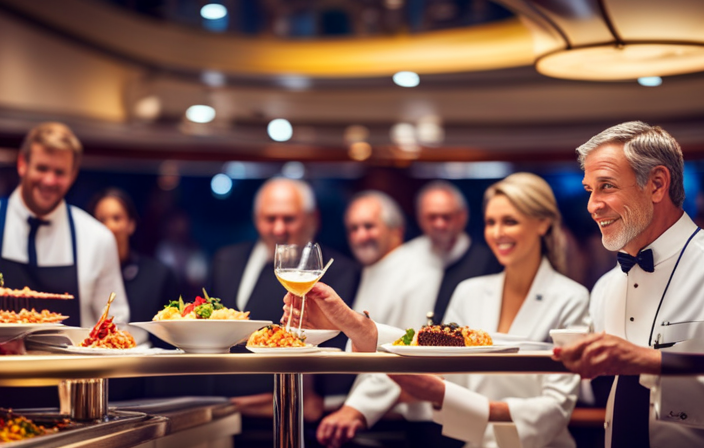In main dining, you’ll enjoy a refined atmosphere with carefully plated dishes served with personalized attention, emphasizing quality and presentation. Buffets, on the other hand, offer a lively, casual environment focusing on variety and quick access to many options, often at a more affordable price. Your choice depends on whether you prefer an elegant, immersive experience or a casual, flexible meal. Keep exploring to discover how each setting can elevate your dining experience.
Key Takeaways
- Main dining offers carefully plated, artisanal dishes in an elegant, relaxing setting, emphasizing presentation and personalized service.
- Buffets provide quick access to a variety of foods in a lively, casual environment focused on speed and abundance.
- Main dining prioritizes quality, ambiance, and a refined experience, while buffets focus on variety, affordability, and convenience.
- The main dining atmosphere is subdued and sophisticated, promoting conversation, whereas buffets are energetic and bustling.
- Your choice depends on whether you prefer a curated, elegant meal or a flexible, casual dining experience.

When choosing where to dine, understanding the differences between main dining and buffet options can help you make the best decision for your meal. In a main dining setting, meal presentation plays a significant role. Your dishes are crafted and plated with care, often reflecting a chef’s artistry and attention to detail. This creates a refined atmosphere where each plate feels like a carefully curated experience. The ambiance differences are noticeable; you’ll find a more formal, elegant setting, with subdued lighting, comfortable seating, and a focus on atmosphere that encourages conversation and relaxation. The presentation of each course is deliberate, emphasizing quality over quantity, and the overall experience feels personalized and immersive.
Main dining offers carefully crafted dishes in an elegant, refined setting that emphasizes presentation and personalized experience.
On the other hand, buffets prioritize variety and immediacy. Meal presentation in a buffet is practical rather than artistic; dishes are arranged on large tables or counters for self-service, often in a way that emphasizes accessibility and abundance. The focus isn’t on plating but on providing a wide array of options that cater to diverse tastes. The ambiance differences are clear—buffet environments tend to be more casual, bustling, and lively. The setting encourages quick dining, with an emphasis on efficiency and choice rather than atmosphere. You might find yourself grabbing plates from a central station and filling your plate with a mix of different flavors, rather than sitting down to enjoy a single, artfully presented dish.
Choosing between these styles depends on your priorities. If you prefer a more sophisticated experience where presentation enhances the meal and ambiance plays a pivotal role, main dining is likely the better fit. You’ll enjoy dishes that are visually appealing and served in a setting that elevates the dining experience. Conversely, if you value variety, speed, and a more relaxed environment, a buffet offers an array of options that you can customize to your liking, often at a more affordable price point. Keep in mind that the ambiance differences also influence your overall enjoyment—whether you prefer the serenity of a fine-dining restaurant or the energetic vibe of a busy buffet.
Ultimately, understanding these distinctions helps you select the dining experience that aligns with your mood, preferences, and the kind of meal you’re craving. Whether it’s the elegant presentation and ambiance of main dining or the abundant, casual atmosphere of a buffet, knowing what to expect ensures you’ll get the most out of your meal.
Frequently Asked Questions
How Do Pricing Models Differ Between Main Dining and Buffet Options?
You’ll find that main dining offers more pricing flexibility, often with à la carte options that let you pay for exactly what you want. Buffets usually have a fixed price, which can enhance your value perception if you eat a lot, but might feel less flexible if your appetite is small. Ultimately, your choice depends on whether you prioritize customizable spending or a straightforward, all-you-can-eat experience.
Are Dietary Restrictions Easier to Accommodate in One Dining Style?
You’ll find dietary restrictions are often easier to accommodate in main dining. Studies show 85% of main dining restaurants offer menu customization for special diets, making it simpler for you to enjoy your meal. Buffets can be trickier because you have less control over ingredients and cross-contamination. With main dining, you get better dietary flexibility, allowing chefs to tailor dishes to your needs and guarantee a safer, more personalized experience.
Which Option Offers Better Quality Control for Food Freshness?
You’ll find that main dining offers better quality control for food freshness because chefs focus on food presentation and carefully select ingredient sourcing. This attention guarantees dishes are prepared fresh and served promptly, maintaining quality. In contrast, buffets often hold food longer, which can affect freshness. So, if freshness matters most, opting for main dining allows you to enjoy meals made with fresh ingredients and expert presentation.
How Do Service Styles and Tips Vary Between Main Dining and Buffets?
In main dining, service approaches are personalized, with servers taking your orders and providing attentive care, which usually means higher tipping expectations. For buffets, you serve yourself, and tips tend to be lower or optional since there’s less direct interaction. Your experience with service styles influences tips—expect to tip more in main dining for the added service, while in buffets, tips often reflect the minimal service provided.
What Are the Typical Wait Times for Each Dining Experience?
You’ll usually wait 10 to 20 minutes for a main dining reservation, especially during peak hours, with reserved seating arrangements ensuring quicker access. Buffets typically have shorter wait times, often just a few minutes, since seating isn’t as limited. However, during busy times, you might wait longer. Planning ahead and making reservations can help you avoid longer waits, especially for main dining experiences where seat availability matters more.
Conclusion
Ultimately, choosing between main dining and buffet depends on your preferences. While buffets offer variety and quick service, main dining provides a more personalized experience. Curiously, some studies suggest that buffets might encourage overeating due to constant access to food, challenging the idea that they’re always the better choice. So, think about what matters most—speed, variety, or quality—and trust your instincts for a dining experience that truly satisfies you.
Claire, a creative soul with an unquenchable thirst for storytelling, is an integral part of the Voyager Info team. As a dedicated writer, she weaves captivating narratives that transport readers to enchanting cruise destinations and beyond.
Claire’s love affair with writing began at an early age when she discovered the magic of words and their ability to craft worlds and emotions. Her innate curiosity led her to explore various literary genres, but it was travel writing that truly captured her heart. Drawing inspiration from her own globetrotting adventures and encounters with diverse cultures, Claire embarked on a journey to become a travel writer par excellence.











